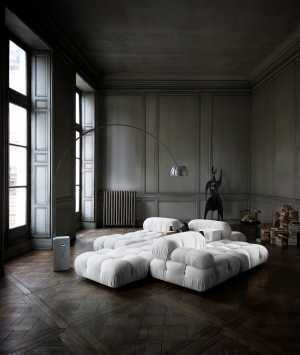Are you an espresso drinker, or do you prefer a latte with your breakfast? Many of us follow the rule of no cappuccino after 11am – a custom rooted in Italian tradition and the belief that the drink is best suited for the morning.
The Italian commitment to the ritual of coffee drinking is not dissimilar to their attitude to design and style: deeply ingrained traditions that allow everyone to indulge and make the best of every experience. There is a deep rooted respect for generational skill, a genuine love for family, and a reverence for history. Now, we could be talking about coffee or design here – and both would still ring true.
Add iconic fashion, masterful architecture, timeless art and world-adored food, all measured by the timelines of empires. Italy’s contribution has left an indelible mark on global design, establishing the country as a major influence for creatives the world over: Classicism, Romanticism, Modernism, Rationalism – all the ‘isms’ collide with trademark Italian flair.
Sitting pretty: Capital's Audrey M armchair by Boatto Martino Studio. The studio was founded by architect Maddalena Boatto and product designer Manuel Martino.
Craftsmanship & passion
When we look at contemporary Italian interiors they are often underpinned by uncompromising quality, using skilled artisans celebrated by region. There is a fierceness and energy to their pursuit of the arts, manifesting inside spaces through colour, material and form.
Craftsmanship and passion is key to unlocking Italian style; there are few shortcuts, and a distinct lack of love for fast fashion and disposable trends.
Italian style can be many things: artisanal and embellished, singular and vibrant and even dare we say, minimalistic. But always guided by rules of composition, with balance and an eye for longevity.
Take Gio Ponti, regarded by many as the father of modern Italian design. As air travel opened up in the 1950s, he became a global phenomenon. Many of his most iconic pieces are still in production, his work celebrated as a benchmark for revolutionary manufacturing techniques and considered creativity. Celebrating its 90th year, Molteni & C has a space on Brompton Road with a stellar collection of his work.
In a similar vein, B&B Italia has updated Mario Bellini’s classic Camaleonda sofa. Still as relevant today, the 1970s icon maintains its modularity and distinctive design but is now manufactured from recycled and recyclable materials.

Mario Bellini’s classic Camaleonda sofa updated with new materials by B&B Italia
Tommaso Sartori
Renaissance Woman
Italian spaces embrace varied influences, resulting in a blend of different design movements. We spoke with Cristina Celestino, the founder of Cristina Celestino Studio and small-scale product business Attico Design.
Her work spans innumerable private residences, restaurants and expos around the world; luxury brand Sergio Rossi commissioned her to create their Milan flagship store experience.
Her approach is to embrace the legacy of each building: “We always try to root the project in the context we find ourselves in, working with contemporary codes but conscious that they interpret the lesson history has given us in that context.
“We did this for an interior project in Rome, a penthouse in a 1930s building, a milestone of Italian rationalism. We like to work with and use natural materials with their own history, ideally connected to the context of the spaces – for example, the travertine used in various ways in Rome.” Her projects represent the very best of modern Italian interior design thinking.
Private house in Rome styled by Cristina Celestino
De Pasquale Maffini
Cristina Celestino, the founder of Cristina Celestino Studio
De Pasquale Maffini
Mediterranean hospitality
Italian interiors shine brightest when welcoming guests. There is a famous Italian expression – pane apre tutte le bocche – which translates as ‘bread opens all mouths’.
The act of sharing food puts guests at ease and it’s that openness and warmth that is so reflective of Italy and its culture: and this love of shared togetherness is innate in the spaces Italian designers create.
Comforting, subtle hues are embraced in subdued interiors, creating inviting spaces. Sometimes juxtaposed with a riot of carefree pattern, often from natural materials. Always a celebration of living life to the fullest though.
What can we do to bring a little piece of Italy into our home? Certainly there are innumerable options for beautiful materials and furniture to give a flavour here in London.
How about savouring a generous glass of Amarone with friends, using a bottle opener by design legend Ettore Sottsass? Maybe that really is la dolce vita.
See more on squaremile.com
